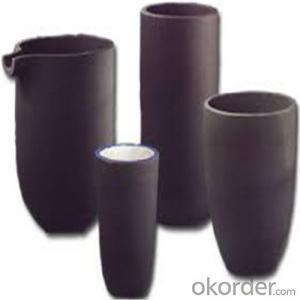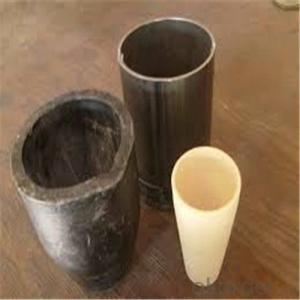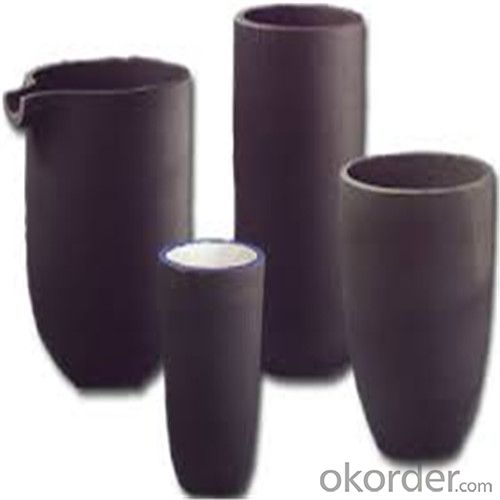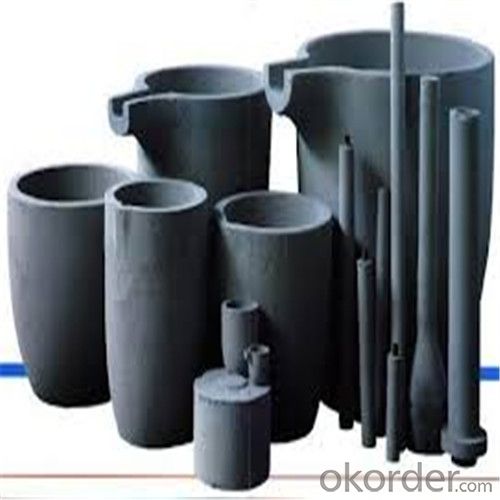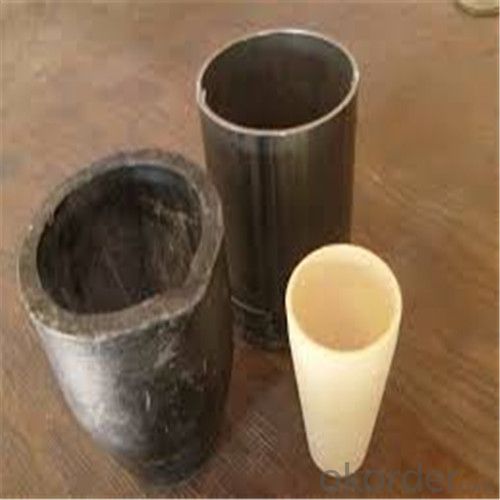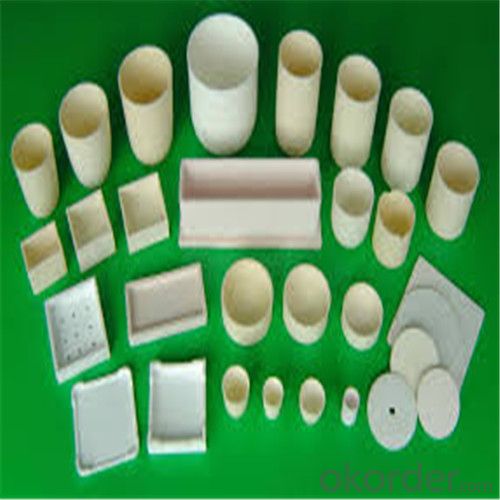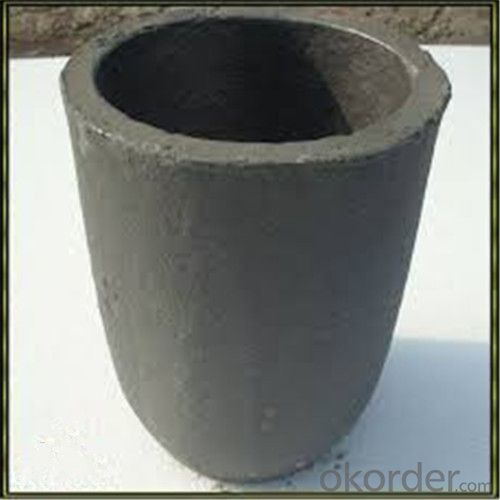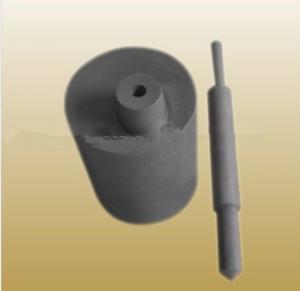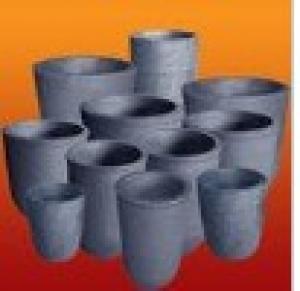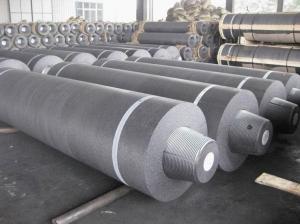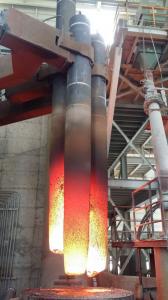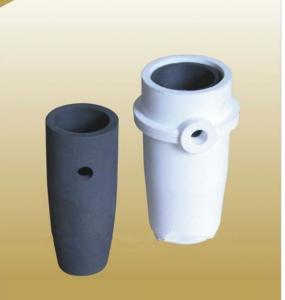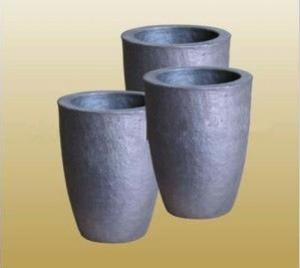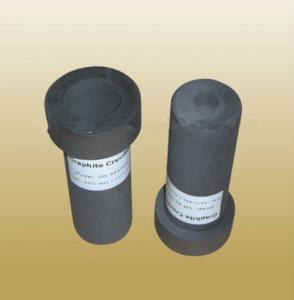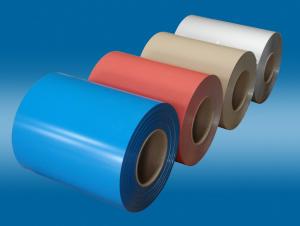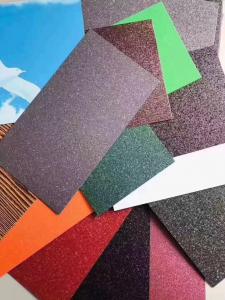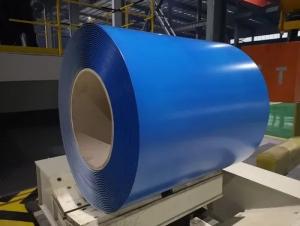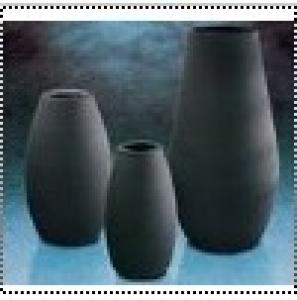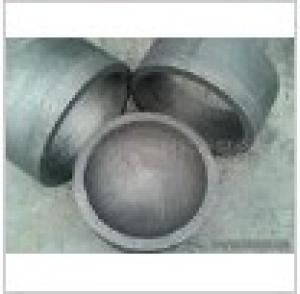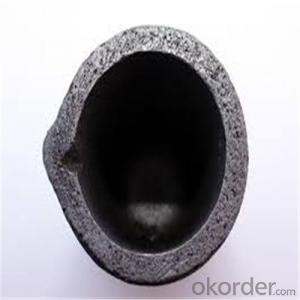Silicon Graphite Crucible for Melting Aluminium, Copper, Brass
- Loading Port:
- Shanghai
- Payment Terms:
- TT OR LC
- Min Order Qty:
- 1 pc
- Supply Capability:
- 1000 pc/month
OKorder Service Pledge
OKorder Financial Service
You Might Also Like
Quick Details for SiC Graphite Crucibles
| Type: | High Strength, graphite crucible crucible | Application: | melting metal | Height: | as your requirements |
| Composition: | High Pure | Top Diameter: | 10-600mm | Bottom Diameter: | 10-1000mm |
| Place of Origin: | China (Mainland) | Brand Name: | Model Number: | ||
| Color: | Black grey | Si3N4%: | 5min | Fe2O3%: | 0.7max |
| C%: | 30-45 | Apparent porosity: | 30max | Refractoriness: | 1680 |
| Bulk Density: | 1.71min | Using life: | >5000 hours | MAX temperature: | 1600c |
Packaging & Delivery
| Packaging Details: | Seaworty packing or as per customer's detail requirement of graphite crucible. |
| Delivery Detail: | within 20-30 days after confirm order of graphite cru |
SiC Graphite Crucibles For Melting Aluminium And Copper, Brass
Product Description
Specifications for Graphite Silicon Carbide Crucible For Aluminum Melting :
1.Long working lifetime: its working lifetime is increased 3-5 times over normal clay-crucible due to the compact body formed under high pressure.
2.High thermal conductivity: high-density body and low apparent porosity greatly improve its heat conductivity.
3.New-style materials: new heat conduction material ensures faster heat conductivity and pollution-free product, reduces adherent slag.
4.Resistance to corrosion:better anti-corrosion than normal clay-crucible.
5.Resistance to oxidation: advanced process dramatically improves its oxidation resistance, which ensures persistent heat conductivity and long working lifetime.
6.High-strength: high-density body and logical structure make the product better compression property.
7.Eco-friendly: energy-efficient and pollution-free, not only ensure metal product purity, but also ensure sustainable development on environment.
8.Multi-function: Can be used in induction graphite crucible furnace
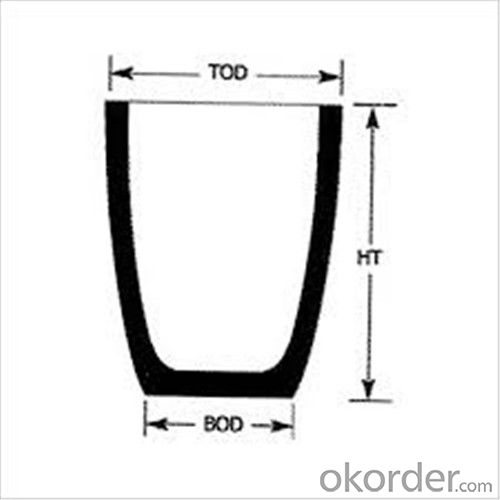

Physicochemical Properties of graphite crucible:
The crucible is an utensil or melting tank vessels that is made of refractory material (such as clay, graphite, quartz or difficult molten metal iron, etc.).
Graphite crucible, with is special advantages and Plasticity, is widely used in the smelting area, e.g. gold smelting, silver smelting, aluminum smelting, cooper smelting, etc.
high pure graphite | ||||
Item | Unit | baked twice | baked three time | baked four times |
impregnated once | impregnated twice | impregnated three times | ||
grain size | mm | ≤325μm | ≤325μm | ≤325μm |
Bulk density | g/cm3 | ≥1.68 | ≥1.78 | ≥1.85 |
Specific resistance | μΩ.m | ≤14 | ≤14 | ≤13 |
Bending strength | MPa | ≥25 | ≥40 | ≥45 |
Compressive strength | MPa | ≥50 | ≥60 | ≥65 |
Ash content | % | ≤0.15 | ≤0.1 | ≤0.05 |
Fine-grain Specialty Graphite FXG-1 | Fine-grain Specialty Graphite FXG-2 | ||||
Item | Unit | Guarantee value | Typical value | Guarantee value | Typical value |
Max grain size | mm | 0.8 | 0.8 | 0.8 | 0.8 |
Bulk density | g/cm3 | ≥1.70 | 1.73 | ≥1.73 | 1.76 |
Specific resistance | μΩ.m | ≤8.5 | 7.5 | ≤8.0 | 7 |
Bending strength | MPa | ≥10.0 | 11 | ≥12.0 | 12.5 |
Compressive strength | MPa | ≥24.0 | 27 | ≥31.0 | 34 |
Thermal Condcutivity | W/(m.k) | ≥120 | 150 | ≥130 | 160 |
C.T.E.(100-600) °C | 10-6/°C | ≤2.5 | 2.2 | ≤2.5 | 2.1 |
Ash content | % | ≤0.3 | 0.09 | ≤0.3 | 0.09 |
NO | Top diameter | Bottom diameter | Height | Tolerance | Capacity(Kg5%) |
2 | 90 | 50 | 55 | 2 | 0.3 |
3 | 105 | 80 | 93 | 2 | 0.5 |
4 | 102 | 80 | 100 | 2 | 0.6 |
5 | 112 | 82 | 130 | 2 | 0.8 |
6 | 120 | 82 | 141 | 2 | 0.9 |
8 | 138 | 90 | 153 | 2 | 1.2 |
12 | 148 | 100 | 181 | 2 | 1.8 |
16 | 156 | 110 | 190 | 2 | 2.3 |
20 | 180 | 120 | 230 | 2 | 3 |
25 | 186 | 128 | 248 | 2 | 3.7 |
Packaging & Shipping
Package: Wooden case and wooden pallet or pack as customer's requirement of graphite crucible.
Delivery time: depend on distance, usually 20 days to 50days after deposit of graphite crucible.
We can supply the products according to customer's drawings, samples and performance requirement.
Other Products

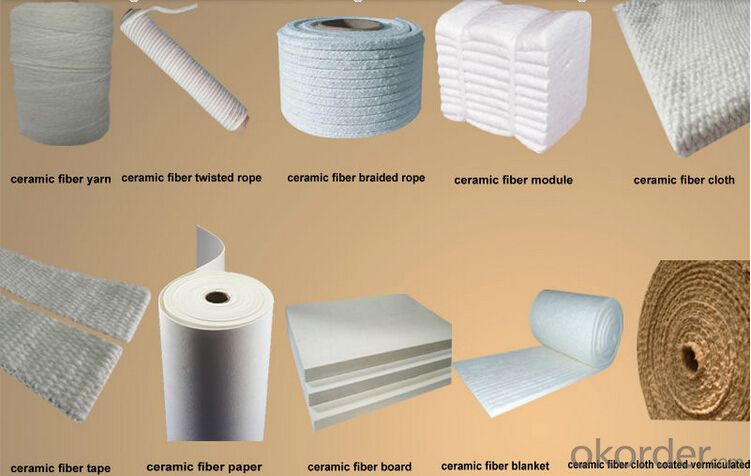
FAQ
1.What's your MOQ?
We will indicate the MOQ for each item in the quotation list. We accept the sample and trail order.
2.Can I negotiate the Prices?
Sure, we may consider discounts for bulk order of products.
3.How long will it take to complete my order?
For the stock items, we can arrange the shippment within 2~3days after received your payment. For the customized items, we will indicate the delivery time in the quotation list.
4.Can you give warranty of your products?
Yes, we extend a 100% satifisfaction guarantee on all items. Please feel free to provide timely feedback if you're not satisfied with N&D's Quality and Service. For the overseas orders, if there is a quality problem, please kindly to provide the picturers to show the problem by e-mail. We will provide the replacements to you at our cost according to actual conditions.
5.Can I visit you?
Sure. If you're a volume buyer and would like to visit our in-house products and production line, please contact us to make an appointment.
- Q:Can a graphite crucible be used for melting magnetic materials?
- No, a graphite crucible cannot be used for melting magnetic materials. Graphite is a non-magnetic material and does not have the ability to generate or sustain a magnetic field. Therefore, it would not be suitable for melting magnetic materials, as it would not be able to interact with or contain them effectively.
- Q:Who is the melting point of graphite and diamond?
- Graphite is a thermodynamically stable structure, while diamond is thermodynamically unstable. Diamond is an atomic crystal, a spatial network structure. Each layer of graphite is netted, and between layers is the intermolecular force, which is the crystal structure between the molecular crystal and the atomic crystal. But because of the bond length, the covalent bond length in the layer of graphite is longer than the bond length of the diamond, and the intermolecular force is greater. The destruction of the chemical bond requires more energy. Agree with this statement. Added, diamond heated to 1900 degrees Celsius will be converted to graphite, graphite more stable.
- Q:Can industrial induction furnaces heat graphite?
- However, it can heat something else and then heat the graphite by heat transfer.
- Q:What are the differences between quartz crucibles and glass crucibles in appearance, properties, uses, etc.?
- In fact, it is not scientific to store sodium hydroxide in quartz bottles or glass bottles. Sodium hydroxide will react with silica, a major component of quartz and glass, to produce sodium silicate with sticky and reactive properties
- Q:Can graphite crucibles be used for powder metallurgy?
- Indeed, powder metallurgy can utilize graphite crucibles. Graphite proves to be an exceptional substance for applications involving high temperatures, and it is frequently employed in powder metallurgy procedures. Graphite crucibles possess a melting point that is notably high and exhibit outstanding thermal conductivity, rendering them perfectly suited for the process of melting and retaining metal powders during sintering or melting operations. Furthermore, graphite crucibles demonstrate commendable chemical resistance, enabling them to endure the corrosive impact of specific metal powders. In summary, graphite crucibles present themselves as a dependable and efficient option for applications within the realm of powder metallurgy.
- Q:How do you determine the appropriate crucible material for a specific application?
- To determine the appropriate crucible material for a specific application, several factors need to be considered. Firstly, it is important to evaluate the temperature range of the application. Different crucible materials have different temperature limitations. For high-temperature applications, materials such as graphite or refractory metals like tungsten or molybdenum may be suitable, while for lower temperature applications, materials like porcelain or alumina may be sufficient. Secondly, the chemical compatibility of the crucible material with the substances being used in the application needs to be assessed. Certain materials may react with specific chemicals or gases, leading to contamination or degradation of the crucible. It is crucial to select a material that is chemically inert or resistant to the substances being used. Thirdly, the thermal conductivity and thermal shock resistance of the crucible material should be taken into account. Some applications require rapid heating and cooling cycles, which can cause thermal stress on the crucible. Materials with high thermal shock resistance, such as quartz or boron nitride, may be more suitable in such cases. Moreover, the mechanical strength and durability of the crucible material should be considered. Some applications involve mechanical forces, stirring, or pouring of molten materials, which can subject the crucible to physical stress. Materials like silicon carbide or stainless steel offer good mechanical strength and can withstand such conditions. Lastly, the cost and availability of the crucible material should be considered. Some materials, such as platinum or iridium, may offer excellent performance but can be expensive and difficult to procure. It is important to strike a balance between performance and cost-effectiveness. In conclusion, determining the appropriate crucible material for a specific application requires considering factors such as temperature range, chemical compatibility, thermal conductivity and shock resistance, mechanical strength, and cost. By carefully evaluating these factors, one can select a crucible material that will meet the requirements of the application effectively.
- Q:Graphite electrode, high temperature resistant oxidation coating, formulation technology
- Technology first, graphite crucible, anti-oxidation coating, water inorganic environmental protection paint, no volatile substance at high temperature and normal temperature. ZS-1021 Weihuanai closed high temperature coating itself with acid and alkali, the quenching medium of any reaction, chemical reaction can effectively protect the graphite crucible under high temperature, can effectively prevent the graphite crucible in high temperature oxidation rate reached more than 95%.
- Q:Is it possible to cast or mold materials using a graphite crucible?
- Yes, it is possible to cast or mold materials using a graphite crucible. Graphite crucibles are commonly used in various industries, such as metal casting, jewelry making, and foundries, due to their high melting point and excellent thermal conductivity. Graphite crucibles can withstand extreme temperatures, making them ideal for melting and casting materials like metals and alloys. Graphite crucibles also have good chemical resistance, which prevents contamination of the molten material. Additionally, graphite crucibles have low thermal expansion and are non-wetting, meaning they do not adhere to the melted material, making it easier to remove the cast or molded material once it has solidified. Overall, graphite crucibles are widely used and highly effective for casting and molding various materials.
- Q:How to judge the thermal stability of rubber oil?
- 1.2 sample containers, crucibles, aluminium crucibles, copper crucibles, platinum crucibles, graphite crucibles, etc. shall not react with specimens and reference materials. 1.3 air source, air, nitrogen and so on, the purity should reach the purity of industrial gas. 1.4 the cooling temperature of the cooling device of the cooling device should be up to -50 degrees centigrade. No enthalpy change occurs in the range of test temperature of 1.5 reference substance. Typical reference materials are calcined alumina, glass beads, silicone oil, or empty containers. Store in a dryer.
- Q:How do you determine the appropriate crucible pouring lip for a specific application?
- The appropriate crucible pouring lip for a specific application is usually determined by considering factors such as the desired pouring speed, the material being poured, the temperature, and the required precision. It is important to choose a lip design that allows for controlled and accurate pouring without spilling or splashing, while also considering the ease of handling and the size of the crucible.
1. Manufacturer Overview |
|
|---|---|
| Location | |
| Year Established | |
| Annual Output Value | |
| Main Markets | |
| Company Certifications | |
2. Manufacturer Certificates |
|
|---|---|
| a) Certification Name | |
| Range | |
| Reference | |
| Validity Period | |
3. Manufacturer Capability |
|
|---|---|
| a)Trade Capacity | |
| Nearest Port | |
| Export Percentage | |
| No.of Employees in Trade Department | |
| Language Spoken: | |
| b)Factory Information | |
| Factory Size: | |
| No. of Production Lines | |
| Contract Manufacturing | |
| Product Price Range | |
Send your message to us
Silicon Graphite Crucible for Melting Aluminium, Copper, Brass
- Loading Port:
- Shanghai
- Payment Terms:
- TT OR LC
- Min Order Qty:
- 1 pc
- Supply Capability:
- 1000 pc/month
OKorder Service Pledge
OKorder Financial Service
Similar products
New products
Hot products
Hot Searches
Related keywords
